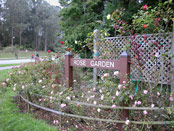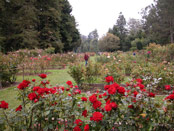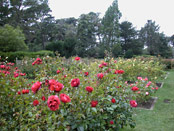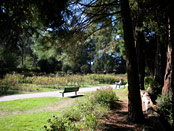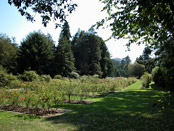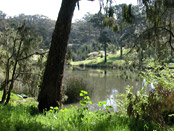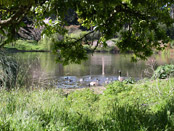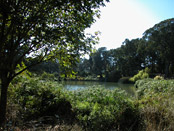Golden Gate Park (Middle)
- » East Section East Edge Horseshoe Courts McLaren Lodge Alvord Lake Alvord Bridge Fuchsia Dell Sharon Meadow Peacock Meadow Children's Playground Kezar Stadium John F Kennedy Drive Martin Luther King Jr Drive Arizona Garden Dahlia Garden Conservatory of Flowers Clarke Gate Raccoon Hollow/Live Oak Ghiradelli Rustic Shelter George Washington Elm Tree Fern Dell Lily Pond AIDS Memorial Grove Tennis Courts Lawn Bowling Courts Brayton Gate Skate Area Garden of Humanitarians Powell Railroad Entrance Brown Gate McLaren Rhododendron Dell Maintenance Yard/Nursery Whiskey Hill
- Middle Section Fulton Playground JFK Pedestrian Tunnel Music Concourse DeYoung Museum Academy of Sciences Shakespeare Garden Big Rec Ball Field Heroes Grove Japanese Tea Garden Botanical Garden Rose Garden Redwood Memorial Grove Colonial Historic Trees Pioneer Log Cabin Rainbow Falls Prayerbook Cross Stow Lake Roman Bridge Rustic Bridge Strawberry Hill Huntington Falls Chinese Pavilion Mothers Meadow Breon Gate Crossover Drive Transverse Drive Middle Drive West Lloyd Lake Portals of the Past Elk Glen Lake Washington Bicentennial Grove
- West Section Marx Meadow Disc Golf Course Speedway Meadow Urban Forestry Center Mallard Lake Metson Lake Lindley Meadow Spreckels Lake Rhododendron Island Golden Gate Park Stables Police Stables Polo Field Par Course South Bridle Path Senior Citizen's Center Pentaque Court Dog Training Area Bison Paddock Fly Casting Pools Chain of Lakes: North Lake Chain of Lakes: Middle Lake Chain of Lakes: South Lake Bercut Equitation Ring Archery Field Golf Course Murphy Windmill Soccer Fields Park Chalet Dutch Windmill Queen Wilhelmina Tulip Garden West Edge
For a summary of park features with point-by-point locations, see the Golden Gate Park guide map. See also Historic Images and Postcards.
Now: Lakes, meadows, and wooded paths stretching over a good portion of Golden Gate Park's length, the middle section has some of the most tranquil and secluded areas in the park.
Then: Most of the lakes in the park, including the lush Stow Lake, did not exist at all before the creation of the park. The entrace way columns of a Nob Hill residence destroyed in the 1906 earthquake and fire were transported to the park as the Portals of the Past monument, at Lloyd Lake.
How To Get There: The middle section is accessible directly via 19th Avenue, which intersects with MLK Drive on the south side and Cross Over Drive on the north. 25th Avenue also has traffic entrances on both the north and south sides. Parking along Fulton Street is easy along the middle Avenues.
For much more information on Golden Gate Park, see Christopher Pollock's impeccably researched and beautifully written book, San Francisco's Golden Gate Park.
Fulton Playground
- Back to Top
The little Fulton Playground, built in 1981, is just inside the park at 9th Avenue. You can walk from the playground to the Music Concourse through the pedestrian tunnel under JFK Drive.
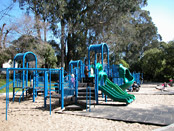
Fulton Playground, near Fulton Street and 9th Avenue
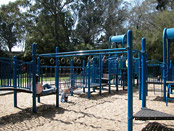
Fulton Playground, facing southwest toward the DeYoung Museum and JFK Tunnel
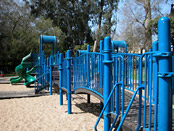
Equipment in the Fulton Playground
JFK Tunnel
- Back to Top
South of the playground, the JFK Drive pedestrian tunnel was designed in 1896. Even something as utilitarian as a traffic bridge was undertaken with fantastic style by the park's builders.
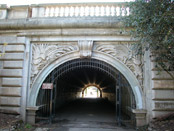
Pedestrian Tunnel under JFK Drive, at the Fulton Playground
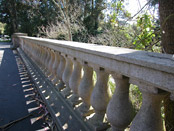
The top of the JFK Drive Pedestrian Tunnel, between 9th and 10th Avenue
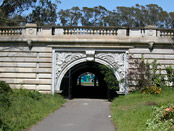
Looking through the JFK Pedestrian Tunnel to the north toward Fulton Playground on the other side
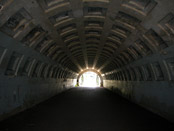
Inside the JFK Pedestrian Tunnel
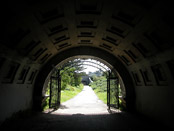
JFK Pedestrian Tunnel near the south exit to the Music Concourse area
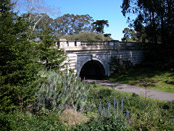
South end of the JFK Pedestrian Tunnel, from the Music Concourse area
Music Concourse
- Back to Top
Developed for the 1894 Mid-Winter Fair, this concourse is now the heart of Golden Gate Park's "museum district". The Music Stand (aka Spreckels Temple of Music) at the west end of the concourse was completed in 1900, and still hosts music performances on Sundays. Many of the park's historically controversial statues are scattered in and around the concourse area. The Pool of Enchantment, originally installed in 1917 at the front of the DeYoung Museum, is now located (post-restoration) on its east side.
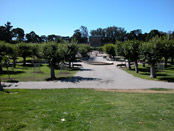
The Music Concourse, looking east
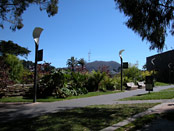
Garden of Enchantment, near the Music Concourse and DeYoung Museum
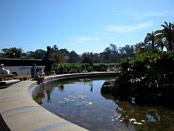
Pool of Enchantment, near the DeYoung Museum
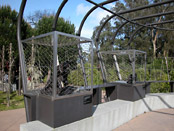
Bronze sculptures inside cages near the Pool of Enchantment in the Music Concourse
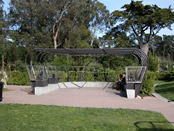
Bronze sculptures in caged enclosures in the Music Concourse area near JFK Drive
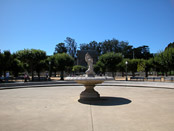
Dry fountain at the center of the Music Concourse
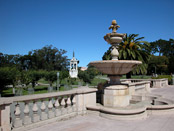
The Music Concourse area, from in front of the Academy of Sciences
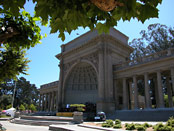
Music Stand, also known as Spreckels Temple of Music, in the Music Concourse

Audience listening to a performance at the Music Stand

Junipero Serra Monument was installed in 1907, near the northeast entrance to the Music Concourse
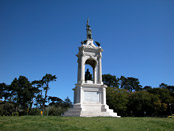
Francis Scott Key Monument, originally installed near the location of the Tennis Courts in 1888
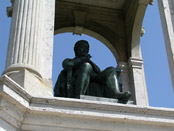
The Francis Scott Key Monument, installed the Music Concourse in 1977, is seen in early images of the park in its previous location
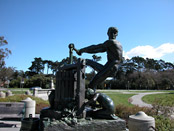
Apple Cider Press statue, sculpted in 1892 and located in the Music Concourse
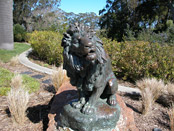
The bronze Lion Statue, a gift from Shreve and Company jewelers, dates back to 1906
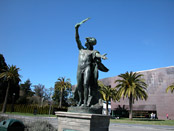
Roman Gladiator Sculpture, made in 1881

Miguel de Cervantes monument, near the northeast entrance to the Music Concourse

Bronze vase created by Paul Gustave Dore in 1878
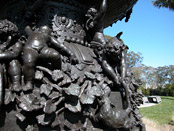
Detail of the Dore Vase, in the Music Concourse
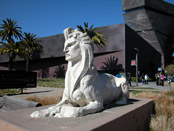
Concrete sphinxes marking the entryway to the DeYoung Museum, since 1928
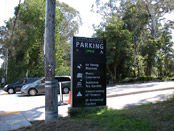
Entrance to the underground parking garage at Fulton and 10th Avenue
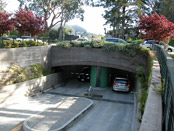
Entrance to the underground parking garage at 10th Avenue and Fulton Street
DeYoung Museum
- Back to Top
Founded in 1895 as the Memorial Museum, and renamed as the DeYoung in 1924 after the San Francisco Chronicle publisher who had guided its development. The original structure was built in Egyptian style. The museum was completely rebuilt and re-opened in 2005. Exhibitions of art and historic artifacts are featured. Open Tuesday through Sunday, 9:30am to 5:15pm. $10 regular adult admission. Entry to the observation tower is free. 415-750-3600. Website.
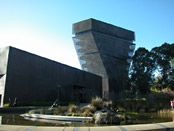
DeYoung Museum, on the north side of Museum Plaza
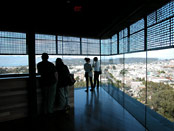
Inside the DeYoung Museum Observation Tower, looking north
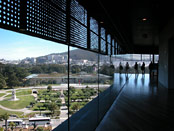
Inside the DeYoung Observation Tower, looking south
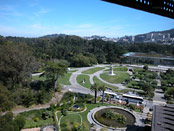
Northeast view from the Observation Tower at the DeYoung Museum
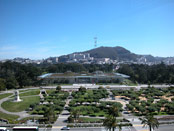
North view from the DeYoung Observation Tower, including the Academy of Sciences Building
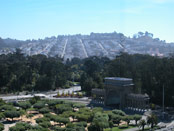
Northwest view from the DeYoung Observation Tower, including the Music Stand
Academy of Sciences
- Back to Top
Originally opening in Golden Gate Park in 1916, the facility later came to include the Steinhart Aquarium (1923), the African Hall (with dioramas), Science Hall, and Morrison Planetarium. Entire generations of children visited on field trips. Completely demolished and rebuilt, the new Academy of Sciences opened in 2008. It now includes the downstairs aquarium, penguins and displays from the African Hall on the ground floor, the rainforest dome, and the living roof. Open Monday through Saturday 9:30am to 5:00pm, and Sunday 11:00am to 5:00pm. $24.95 regular adult admission. Thursday nights 6:00pm to 10:00pm, adults 21+ only ($12). 415-379-8000. Website.
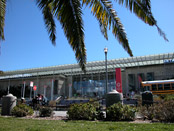
Front of the Academy of Sciences Building
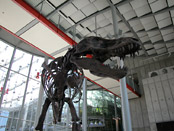
Inside the front lobby of the Academy of Sciences building
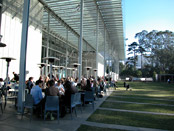
Dining tables outside the back of the Academy of Sciences
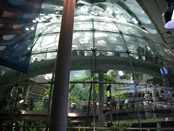
The Rainforest Dome, inside the Academy of Sciences

Inside the Rainforest Dome, from the upper level
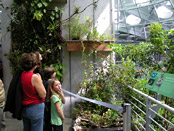
Observing butterflies at the top of the Rainforest Dome
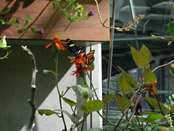
Butterflies in the top level of the Rainforest Dome
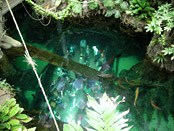
Inside the Rainforest dome, looking down at part of the aquarium from above
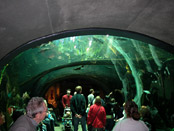
Walkway below the same section of aquarium
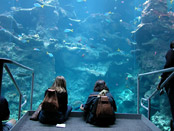
Visitors watching the aquarium
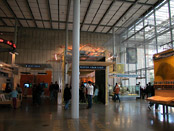
The east section of the Academy of Sciences
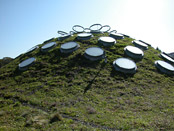
On the roof of the Academy of Sciences, at the above the Rainforest Dome
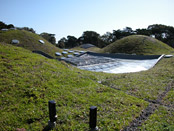
Center of the living roof at the Academy of Sciences
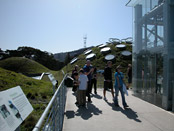
Visitors on the observation deck of the living roof
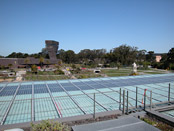
The DeYoung Museum, viewed from the roof of the Academy of Sciences
Shakespeare Garden
- Back to Top
Established in 1928, this formal garden features plants and flowers mentioned in Shakespeare's writings. The garden's marble bench was added in 1929. The iron entrance gate was added during a renovation in 1991. It's located just south of the Academy of Sciences.
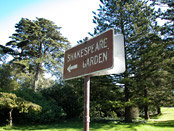
Entrance to the Shakespeare Garden, from MLK Drive
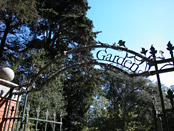
Entrance gate to the Shakespeare Garden
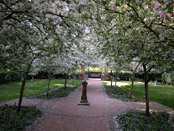
Blossoms on the trees in the Shakespeare Garden in the spring
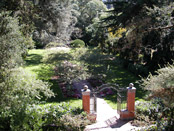
Shakespeare Garden, from above
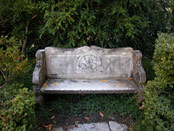
Bench inside the Shakespare Garden
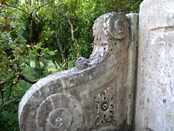
Detail of marble bench inside the Shakespare Garden
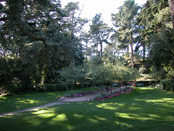
The Shakespeare Garden
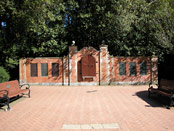
East wall inside the Shakespeare Garden
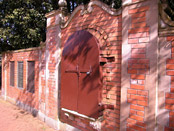
The bust of Shakespeare is locked behind the steel doors in the wall at the end of the Shakespeare Garden
Big Rec Ball Field
- Back to Top
Two back-to-back baseball diamonds on an incredibly large stretch of lawn. This patch of green stands out clearly when looking down at the park from the vantage point of Grand View Park in Golden Gate Heights. Two indoor handball courts are situated just north of the Big Rec Fields, off of Middle Drive East. On the east side of the handball courts, a path leads up toward the DeLaveaga Dell/AIDS Memorial Grove. Two rings of stones, possibly headstone pieces, lie embedded in a clearing around a tree on the path south of Middle Drive East. The ball fields are available for reservation. 415-831-5510.
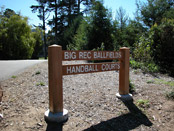
Entrance to the Big Recreation Fields and Handball Courts, from Middle Drive East

Handball Courts, just north of the Big Rec Fields
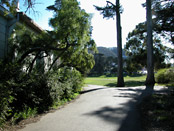
Path around the Handball Courts at the Big Rec Field
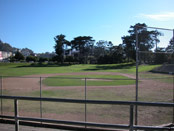
Big Rec Ball Field, at the edge of Lincoln Avenue at 7th Avenue
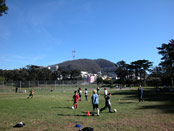
Looking south toward Lincoln Avenue from the playing field at 7th Avenue
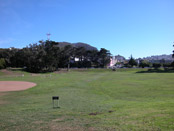
South view from the Big Rec Field
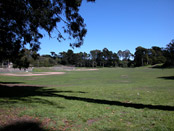
The two baseball fields in the Big Rec area, from the south side
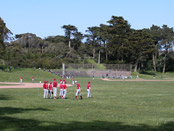
Ball players on the west side of the Big Rec Ball Field

A ball game in progress at the east side of the Big Rec Ball Field
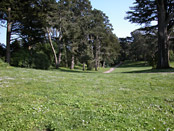
Walking path along the east side of the Big Rec Ball Field
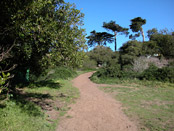
Path from the Handball Courts and Big Rec Field toward the AIDS Memorial Grove
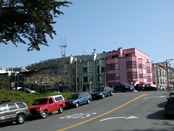
Park entrance at 7th Avenue and Lincoln Way, at the Big Rec Ball Field
Heroes Grove
- Back to Top
Tranquil grove of coastal redwoods, surrounding a granite rock inscribed with the names of local casualties of World War I. Paths lead from the Rose Garden through this wooded area to the Music Concourse entrance at 10th Avenue. The grove was dedicated in 1919, and the memorial rock was added in 1932. The entrances are easy to miss, and most visitors pass by on JFK Drive without noticing this part of the park.
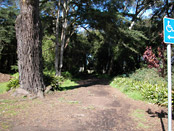
Entrance to the Heroes Grove from JFK Drive near the DeYoung Museum
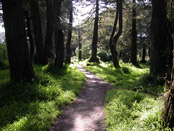
Walking path inside the Heroes Grove
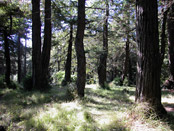
Wooded area west of the monument in Heroes Grove
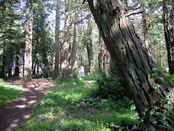
Trees in the Heroes Grove
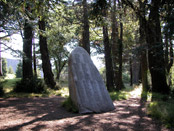
Gold Star Mothers Rock, at the center of Heroes Grove

Gold Star Mothers Rock, inscribed with names of WW1 casualties
Japanese Tea Garden
- Back to Top
Dating to 1894, this garden's current beautiful state belies a turbulent political history. The Hagiwara family, original caretakers of the garden, were evicted and sent to an internment camp during World War II. Until 1952, the garden was called Oriental Tea Garden, removing the reference to its Japanese origin. Open daily 9:00am to 6:00pm (March-October), 9:00am to 4:45pm (November-February). $5 adult admission ($7 non-SF residents). Free entry before 10am Monday, Wednesday and Friday. 415-666-3232. Website.
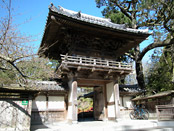
Entrance to the Japanese Tea Garden
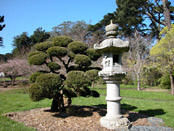
Lantern dedicated to the Japanese pioneers
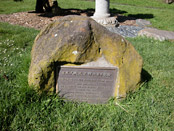
Plaque at the lantern dedicated to Japanese pioneers
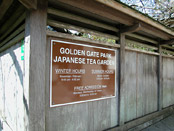
Hours posted for the Japanese Tea Garden
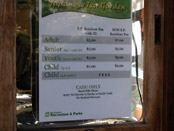
Admission prices for the Japanese Tea Garden
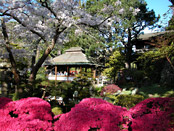
Japanese Tea Garden near the entrance
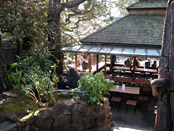
Tables in the Japanese Tea Garden where tea is served
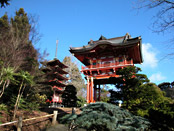
Decorative archway and pagoda inside the Japanese Tea Garden
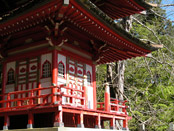
Detail of the pagoda in the Japanese Tea Garden
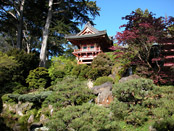
Pagoda inside the Japanese Tea Garden
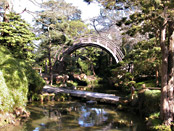
Lake and Moon Bridge inside Japanese Tea Garden

Moon Bridge inside the Japanese Tea Garden

Stone pathway across a pond in the Japanese Tea Garden
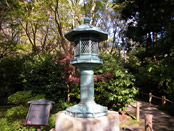
Peace Lantern, in the Japanese Tea Garden
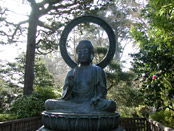
Buddha in the Japanese Tea Garden dates back to 1790
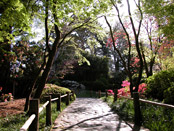
Path inside the Japanese Tea Garden
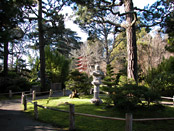
Walking path in the Japanese Tea Garden
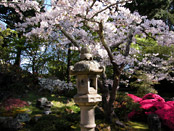
Cement lantern in the Japanese Tea Garden
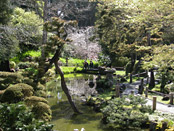
Pond inside the Japanese Tea Garden
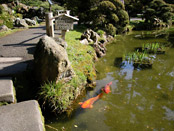
Pond inside the Japanese Tea Garden with Koi fish
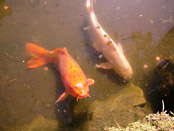
Koi fish in the pond at the Japanese Tea Garden
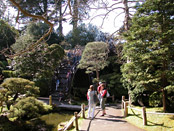
People taking pictures at the curved bridge in the Japanese Tea Garden
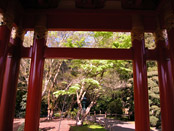
Inside the ornamental archway in the Japanese Tea Garden
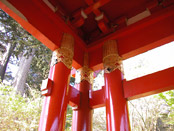
Detail of the ornamental arch in the Japanese Tea Garden
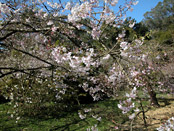
Blossoms on the trees in the Japanese Tea Garden
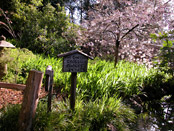
Grass at the corner of the Japanese Tea Garden

Rear exit from the Japanese Tea Garden, near the Friend Gate to the Botanical Garden and entrance to Stow Lake
County Fair Building
- Back to Top
This building sits at the main entrance to the Botanical Garden on 9th Avenue near Lincoln Way. It was dedicated in 1960 and was intended as a hall of flowers - a display area for indoor specimens. It now hosts expositions and public events.
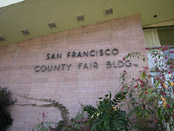
Sign on the San Francisco County Fair Building, at 9th Avenue near Lincoln Way
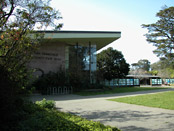
Outside of the San Francisco County Fair Building
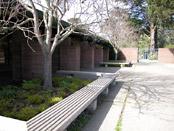
Courtyard at the entrance to the San Francisco County Fair Building
Botanical Garden
- Back to Top
This vast 55-acre collection of geographically themed gardens offers the opportunity to see (and learn the names of) plant specimens from all over the world. It also features some of the most charming walking paths and grassy picnic areas in all of Golden Gate Park. Gates are open 8:00am to 4:30pm weekdays, 10:00am to 5:00pm weekends. Free admission. Free guided walks daily at 1:30pm. 415-661-1316. Website.
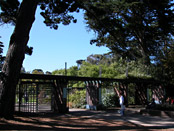
Main entrance to the Botanical Garden, near 9th Avenue
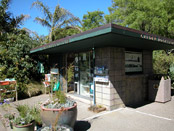
Bookstore at the main entrance to the Botanical Garden
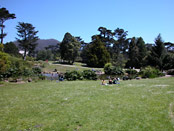
Inside the Botanical Garden
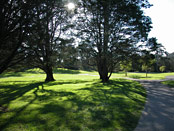
Walking paths inside the Botanical Garden, near the east entrance
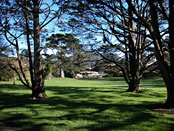
Looking back toward the main entrance from inside the Botanical Garden
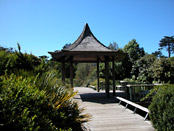
Walkway and pagoda in the Garden of Fragrance area of the Botanical Garden
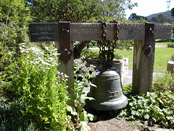
Mexican Bell, made in 1847 and brought from Mexico
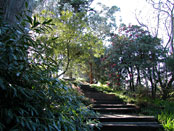
Steps leading up a hill at the Garden of Fragrance
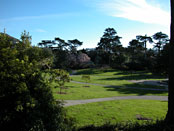
View of walking paths from hill in the Botanical Garden
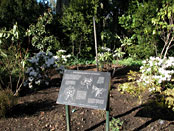
Information about plant types in the Botanical Garden
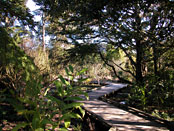
Wooden walkway in the north section of the Botanical Garden
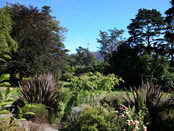
Inside the Botanical Garden, near the Friend Gate
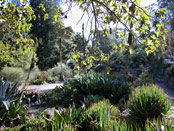
The Succulent Garden inside the Botanical Garden
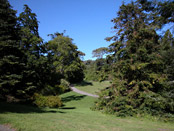
Clearing west of the Moon Viewing Garden
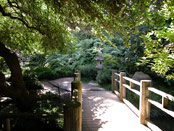
Bridge near the Moon Viewing Garden inside the Botanical Garden
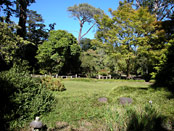
The Moon Viewing Garden, inside the Botanical Garden
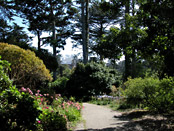
Path near California Natives section inside Botanical Garden
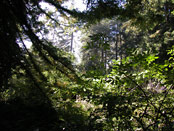
California Redwoods inside the Botanical Garden
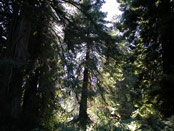
Redwood Nature Trail, inside the Botanical Garden
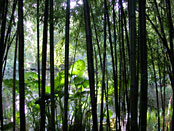
Bamboo grove near south edge of Botanical Garden
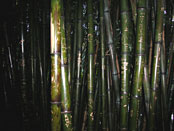
Carved inscriptions on Bamboo stalks
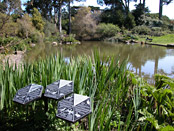
Pond inside the Botanical Garden near the Friend Gate
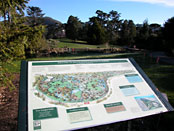
Botanical Garden map on display near the Friend Gate on the north side
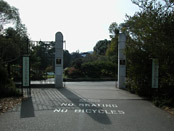
The Friend Gate entrance to the Botanical Garden, from MLK Drive
Rose Garden
- Back to Top
Developed in 1961, this garden is situated between the Park Presidio Boulevard Entrance at Fulton Street and JFK Drive, just west of the Music Concourse. Roses in red, pink, yellow, and orange manage to survive despite the park's frequent foggy days, and are in full bloom during late summer.
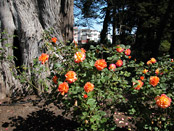
Roses near the Fulton Street entrance to the Rose Garden
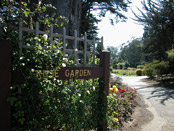
Rose Garden entrance at Fulton Street
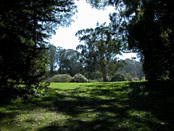
Clearing west of the Rose Garden
Redwood Memorial Grove
- Back to Top
The meadow adjacent to this grove and the Doughboy Statue with laurel wreath are easy to notice while passing by on JFK Drive, but the redwood grove itself is visited less often. The trees were planted in 1930 in honor of war casualties, and have since grown enough to create a dense, shady grove.
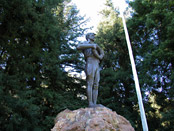
Doughboy Statue at the Redwood Memorial Grove
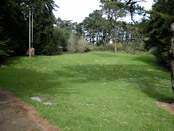
Meadow on the east side of the Redwood Memorial Grove
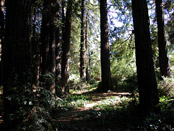
Inside the Redwood Memorial Grove, on the north side of JFK Drive from the Colonial Historic Trees
Colonial Historic Trees
- Back to Top
Planted in 1896, this grove includes a tree for each of the 13 Colonies. Each tree is a different type, native to the area it represents. The gently sloping meadow and ring of trees create a tempting vista when you're passing by on JFK Drive. The bizarre Pioneer Mother Statue also tends to call attention, and is rumored to be a creepy sight on foggy nights.
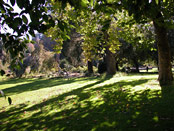
Colonial Historic Trees, just south of JFK Drive and north of Stow Lake
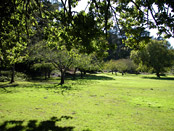
The grove of Colonial Historic Trees
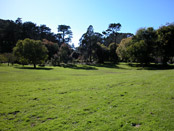
Lawn at the Colonial Historic Trees
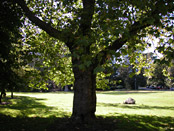
West view from under one of the trees in the Colonial Historic grove
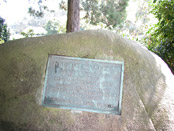
Boulder and plaque at the Colonial Historic Trees
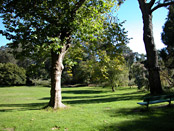
Bench at the Colonial Historic Trees, facing east
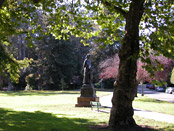
Pioneer Mother statue, from the Colonial Historic Trees
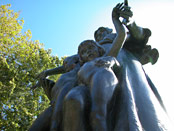
Pioneer Mother Statue, the work of Charles Grafly, 1915

Detail of the Pioneer Mother statue
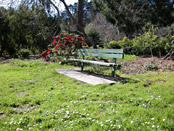
Bench at the meadow near the Colonial Historic Trees
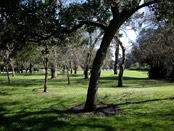
The Colonial Historic Trees in March
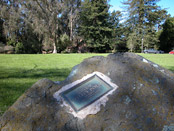
Willis Polk Rock, near the Colonial Historic Trees and Pioneer Log Cabin
Pioneer Log Cabin
- Back to Top
Constructed in 1911 from redwood logs (floated down in the form of a raft down the coast from Humboldt County), to honor the pioneer women of California. The cabin now houses the Permits Division of the Park Department.
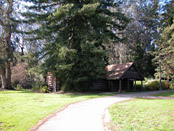
Path leading to the Pioneer Log Cabin
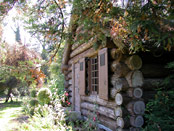
Pioneer Log Cabin, west of the Colonial Historic Trees
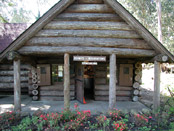
Permits office, located in the Pioneer Log Cabin
Rainbow Falls
- Back to Top
Named for the colored lights that originally framed the falls at their dedication in 1930, this is the second of two artificial waterfall systems created in Golden Gate Park (the other being Huntington Falls in Stow Lake). Water is pumped from nearby Lloyd Lake, and circulated in the trench stream along JFK Drive. The very top of the falls is enclosed by fences, so no vantage point looking down over the cascade is possible.
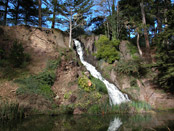
Rainbow Falls, looking up toward Prayer Book Cross, at JFK Drive near Crossover Drive
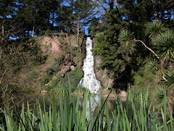
Rainbow Falls and Lagoon

Full view of Rainbow Falls, from the lagoon

Rainbow Falls, from a near vantage point
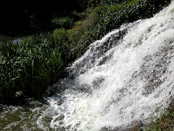
Bottom of the cascade at Rainbow Falls
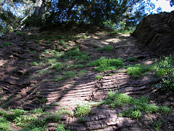
Part of the rock wall of the cove where Rainbow Falls in located
Prayerbook Cross
- Back to Top
The Prayerbook Cross near the top of the falls is another 1894 relic, and may be reached via a trail up the hill. In early photos, the cross is seen clearly on the hill (and is referred to as "Drake's Cross". Full grown trees now hide the cross almost completely from street level. At 64 feet, it is the tallest monument in the park.
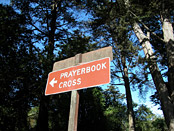
Sign marking the entrance to the trail leading up to Prayerbook Cross, from JFK Drive
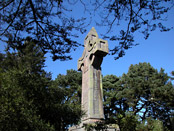
Prayerbook Cross, at the top of Rainbow Falls near JFK Drive
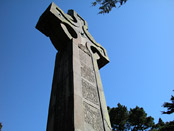
Prayerbook Cross, from a close vantage point
Stow Lake
- Back to Top
A landscaping masterpiece, it's very hard to believe that this lake was built from nothing. Finished in 1893, this quintessential feature of Golden Gate Park was a featured part of the 1894 Midwinter Fair. The lake itself forms a ring around Strawberry Hill, with three smaller islands in the lake for wildlife habitation. Two bridges connect the outside shore of the lake to Strawberry Hill. At the northwest corner of Stow Lake, boat rentals are available at the front entrance, bicycles and surreys at the back. 415-752-0347.
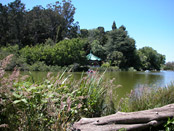
Strawberry Hill and the Chinese Pavilion from the edge of Stow Lake
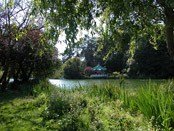
Stow Lake and Chinese Pavilion
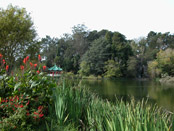
Chinese Pavilion and Huntington Falls, seen from the outer banks of Stow Lake
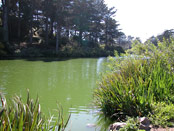
Stow Lake and Strawberry Hill, from the south shore
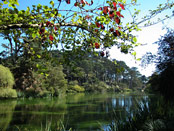
Stow Lake, looking south toward Strawberry Hill
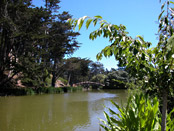
Stow Lake and Rustic Bridge, near Martin Luther King Jr Drive and Crossover Drive
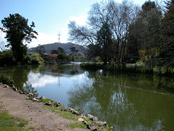
Looking south toward Sutro Tower from the east shore of Stow Lake
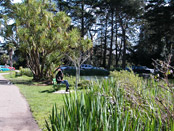
Bench on the outer shore of the east area of Stow Lake
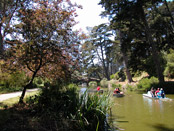
Stow Lake, near Rustic Bridge
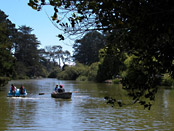
Boats on Stow Lake

Path around the outer bank of Stow Lake

Iceplants and reeds along the inner shore of Stow Lake near the Rustic Bridge
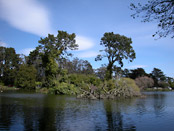
Wildlife nesting island in east area of Stow Lake near Huntington Falls
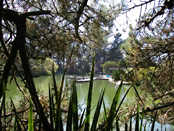
View of the Boat Dock at Stow Lake
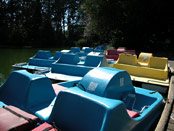
Empty Pedal Boats at Stow Lake
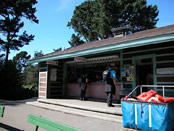
Snack Bar and Boat Rentals on the north side of Stow Lake

Bike and Surry Rentals, at the back of the Boat House on the north side of Stow Lake
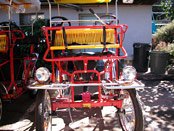
Front of Surrey Quadricycle at rental area
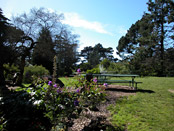
Picnic Area at the northwest side of Stow Lake, near the Bike Rental area
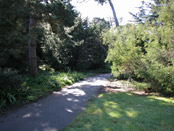
Path to the north area of Stow Lake from JFK Drive near Rainbow Falls
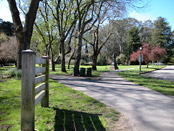
Sign marking the path to Stow Lake from JFK Drive near the Colonial Historic Trees
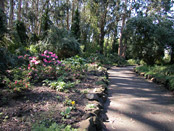
Path leading to Stow Lake from JFK Drive near the Pioneer Log Cabin
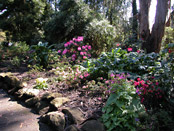
Flowers in the path leading to Stow Lake from JFK Drive near the Pioneer Log Cabin
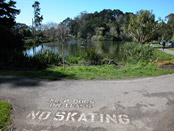
East entrance to Stow Lake, from the stairs near the exit from the Japanese Tea Garden
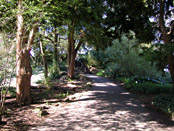
Path leading to Stow Lake from the rear exit of the Japanese Tea Garden
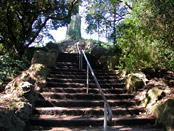
Stairway leading up to Stow Lake from the path at the Tea Garden exit
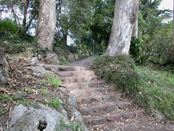
Steps leading up to Stow Lake from MLK Drive
Roman Bridge
- Back to Top
The plain Roman Bridge and its counterpart, the rocky Rustic Bridge, both date to 1893.
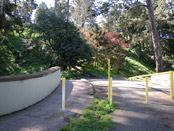
Entrance to the Roman Bridge from the outer shore of Stow Lake
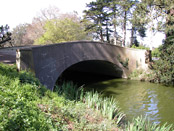
The Roman Bridge, connecting Strawberry Hill with the Stow Lake perimeter
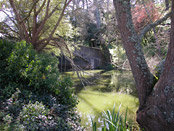
Stow Lake and Roman Bridge in the north area of Stow Lake
Rustic Bridge
- Back to Top
The Rustic Bridge and Roman Bridge were both completed in time for the 1894 Midwinter Fair. Then, as now, they allow pedestrians to walk from the outer shore of Stow Lake to the island of Strawberry Hill, and boats to travel underneath.
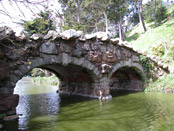
Rustic Bridge from the outer shore of Stow Lake
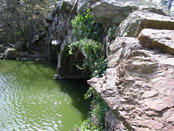
The edge of Rustic Bridge, from the west side
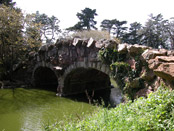
Rustic Bridge, from the inner shore of Stow Lake at Strawberry Hill
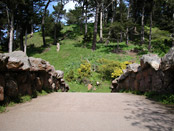
Top of the Rustic Bridge, looking toward Strawberry Hill
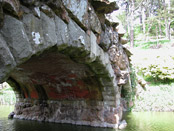
Under the Rustic Bridge, on the surface of Stow Lake
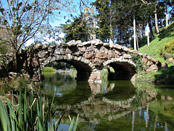
The Rustic Bridge, reflected in Stow Lake
Strawberry Hill
- Back to Top
The island hill, the highest point in Golden Gate Park, is surrounded by Stow Lake. Paths lead around the perimeter of the hill, and steps lead up the west and east sides. Sweeney Observatory, a castle-like concrete structure sat atop the hill from 1891 to 1906, when it was ruined in the earthquake.
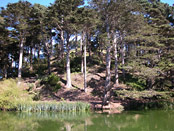
Strawberry Hill, from the west side of Stow Lake

Steps leading up to the top of Strawberry Hill
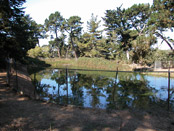
Reservoir at the top of Strawberry Hill
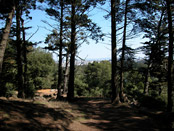
Path at the top of Strawberry Hill, facing east
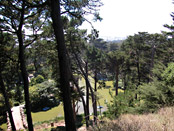
Looking down at Stow Lake from the top of Strawberry Hill
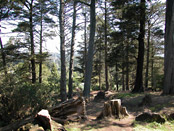
The top of Strawberry Hill

Possibly part of the foundation of Sweeney Observatory, at the top of Strawberry Hill
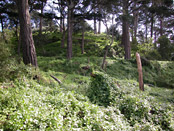
Looking up at Strawberry Hill, from its north perimeter
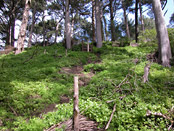
Path leading up Strawberry Hill, on the west side
Huntington Falls
- Back to Top
Huntington Falls was inspired by a visit John McLaren made to the Sierras with naturalist John Muir. The sculpted rocks around the falls look a little theme park-ish, but it's no less scenic when you're climbing the adjacent stairs.
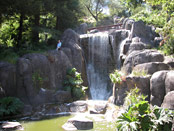
Huntington Falls, from the bottom of Strawberry Hill
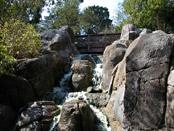
Huntington Falls, from a rock near the top
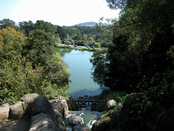
Looking down over the top of Huntington Falls at Strawberry Hill
Chinese Pavilion
- Back to Top
This structure was a gift from San Francisco's sister city, Taipei, and was dedicated in 1981.
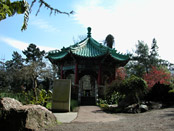
The Chinese Pavilion, on the inner shore of Stow Lake
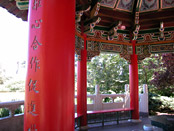
Chinese Pavilion at the foot of Strawberry Hill

Detail of a column on the Chinese Pavilion Structure at Stow Lake
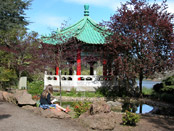
Small pond on the south side of the Chinese Pavilion at Stow Lake
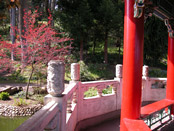
Side of the Chinese Pavilion, from inside
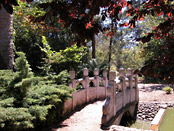
Bridge at the Chinese Pavilion near the edge of Strawberry Hill and Stow Lake
Mothers Meadow
- Back to Top
It's hard to miss this meadow from MLK Drive, as it's a strikingly large patch of relatively flat grass. There are trees around the perimeter, but the lawn itself is wide open. A playground sits in the back, and paths on the east and west side connect with Stow Lake.
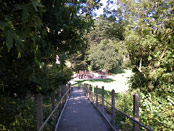
Path leading to Mothers Meadow and Playground from MLK Drive
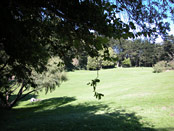
Mothers Meadow at MLK Drive near 18th Avenue
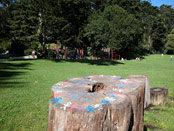
Stump near the entrance to Mothers Meadow from MLK Drive
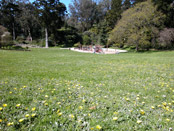
The field at Mothers Meadow, facing north
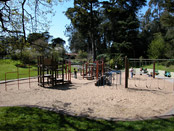
Playground in Mothers Meadow
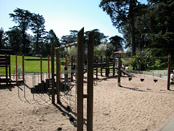
The playground at Mothers Meadow
Breon Gate
- Back to Top
More vehicle traffic passes through this gate at 19th Avenue and Lincoln Way than any other entry point to the park. The pillars were a gift from a wealthy family and were dedicated in 1923.
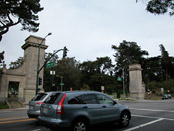
Breon Gate, at the 19th Avenue entrance to the park
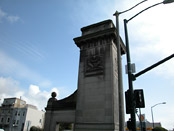
Column of the Breon Gate at 19th Avenue and Lincoln Way
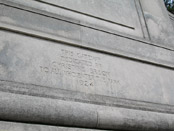
Inscription on the column of Breon Gate, dating to 1924
Crossover Drive
- Back to Top
This well-named road consists of four traffic lanes slicing through the middle of the park from south to north. At JFK Drive it literally crosses over via traffic bridge and then splits toward 25th Avenue to the west and Park Presidio Boulevard to the east. It's bascially the main way to drive through the park if your intent is to get to the other side without stopping.
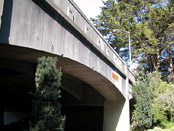
The Crossover Drive traffic bridge over JFK Drive
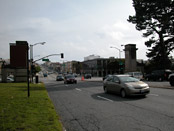
Cars entering the south side of the park at 19th Avenue
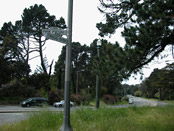
Intersection of Crossover Drive and Park Presidio
Transverse Drive
- Back to Top
Parallel to Crossover Drive, Transverse is the road you take if you want to travel north-south without leaving the park. It's also a great relatively quiet street to park on with access to the middle section of the park.
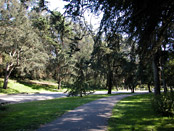
Transverse Drive, south of Overlook Drive
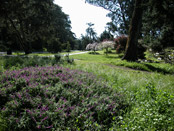
Transverse Drive near the path leading to Elk Glen Lake
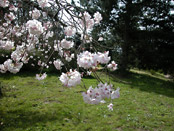
Blossoms on the plum trees along Transverse Drive, near Elk Glen Lake
Middle Drive West
- Back to Top
Middle Drive East and West are two parts of a road travelling east-west through the middle of the park. The west section is closed to through traffic and one portion south of Speedway Meadow is blocked off as a bicycle training area.
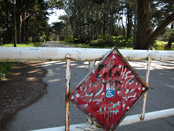
Middle Drive West closed south of Speedway Meadow for designated bicycle training area
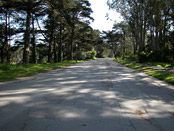
Middle Drive West, closed to traffic
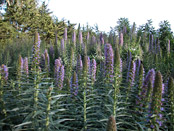
Purple brush plants near Middle Drive West
Lloyd Lake
- Back to Top
This is the reservoir for the water pumped up its adjacent hill to Rainbow Falls. The water is circulated via the JFK Drive stream, and pours back into the lake in a cascade at its southwest corner. A trail entrance from Transverse Drive leads up the hill overlooking the water. The lake itself has a placid, dreamlike quality due in part to the stately presence of the Portals of the Past. It was also previously referred to as Mirror Lake.
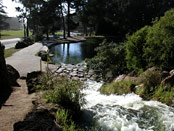
Overlooking the waterfall on the east side of Lloyd Lake
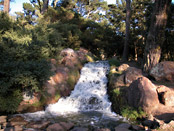
Waterfall at Lloyd Lake
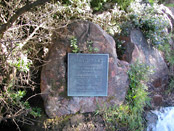
Plaque at the waterfall on the east side of Lloyd Lake
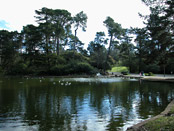
View toward the waterfall from the east side of Lloyd Lake

Lloyd Lake and the waterfall
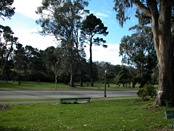
JFK Drive and Speedway Meadow, from the south shore of Lloyd Lake
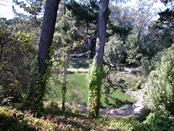
Lloyd Lake from the hill between Transverse Drive and the lake
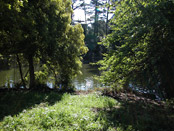
The north shore of Lloyd Lake
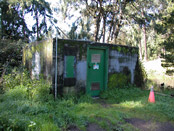
Pump house, behind the trees on the northeast shore of Lloyd Lake
Portals of the Past
- Back to Top
Part of the entrance for a Nob Hill Mansion destroyed in the 1906 earthquake. The columns, left standing after the collapse of the house, were transported to the park and installed in 1909 as a memorial.
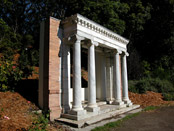
Portals of the Past monument to the 1906 earthquake
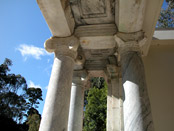
Looking up at the Portals of the Past, from inside the archway
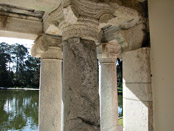
One of the back columns on the Portals of the Past has crumbled
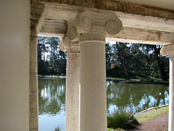
Another of the back columns on the Portals of the Past has been replaced
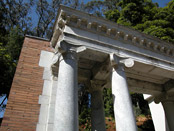
Corner of the Portals of the Past structure

Portals of the Past, from the path on the north side of Lloyd Lake
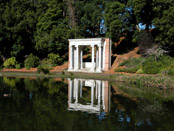
Portals of the Past and its reflection in Lloyd Lake
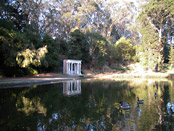
Lloyd Lake and Portals of the Past
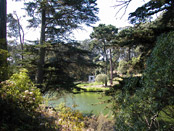
Portals of the Past from the hill above Lloyd Lake
Elk Glen Lake
- Back to Top
Created in 1936, this lake is adorned by plum and cherry trees on its east side, and surrounded by wild grasses that grow high in the early spring. Its location deep in the middle of Golden Gate Park, and the fact that no major road passes its shore, makes this one of the most hidden and seldom-visited features of the park.
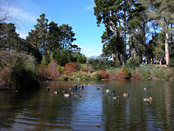
Elk Glen Lake, off of MLK Drive
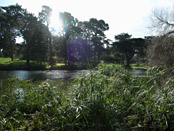
Elk Glen Lake, from the north shore

The south shore of Elk Glen Lake
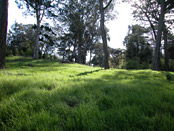
Grassy hillside on the north shore of Elk Glen Lake
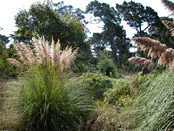
Willows at Elk Glen Lake

Fruit tree at the shore of Elk Glen Lake
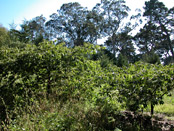
Cherry Trees on the east side of Elk Glen Lake
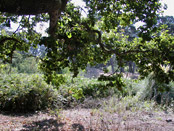
Tree near Elk Glen Lake
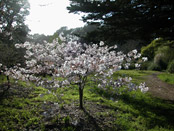
Blossoms on the cherry trees at Elk Glen Lake
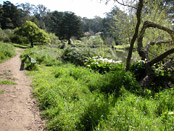
Path leading away from the north side of Elk Glen Lake
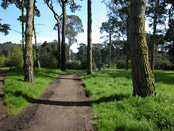
Path near Elk Glen Lake and the Urban Forestry Center
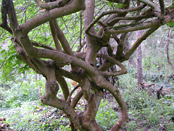
Twisted tree on the path leading west from Elk Glen Lake
Washington Bicentennial Grove
- Back to Top
Planted in 1932, this grove was apparently meant to honor the 200th anniversary of George Washington's birth, not the bicentennial of US independence. The redwood tree dedicated to Herbert Hoover was planted in 1935, according to the plaque beneath it.
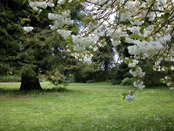
Facing out toward the walking path along MLK Drive from Washington Bicentennial Grove
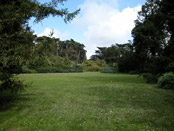
Lawn at the Washington Bicentennial Grove
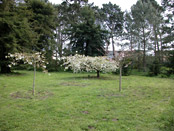
Blossoming trees in the Washington Bicentennial Grove at MLK Drive, just west of Transverse Drive
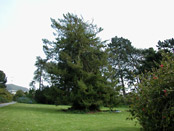
Herbert Hoover Tree at the Washington Bicentennial Grove
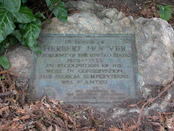
Plaque under the Herbert Hoover Tree at the Washington Bicentennial Grove
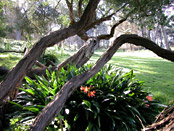
Meadow west of Crossover Drive (19th Avenue) and Lincoln Way, near the Washington Bicentennial Grove
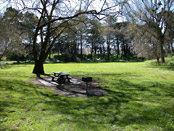
Picic area and meadow near the 25th Avenue entrance to the park at Lincoln Way
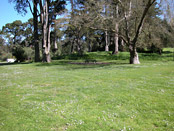
North view across the meadow and picnic area toward MLK Drive
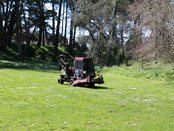
Maintenance mower on the meadow near Bicentennial Grove
Comments
Comment about the Middle section of Golden Gate Park here:

